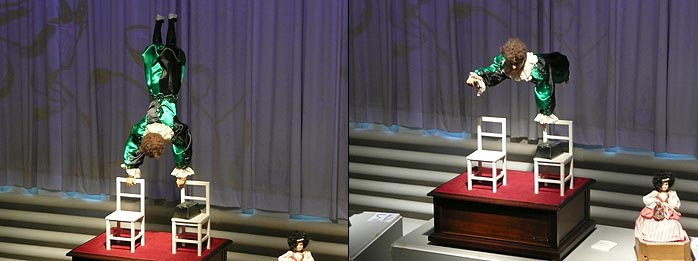|
This page is supported in part by the sponsors whose ad banners are displayed below
|
|
 |
|
|
In a more carnveval-esque mold was the automated acrobat who pressed into a perfect hand stand atop two chairs, then held himself suspended horizontally on first two arms, then one.
|
|
|
 |
|
 |
|
A strong arm of a different kind was put into action in a later exhibit...
|
|
|
|
|
|
... when a 1938 Thorens table lowered its needle to shellack and commenced to play to perfection.
|
|
 |
|
|
But there were earlier examples still chez Cima, of Thorens contributions to music playback in the home. One of them didn't play vinyl but binary discs, the successors to the tuned-comb music boxes actuated by cylinders with embedded pins (house wives were paid by the hundred pins and the average such worker inserted between 700 and 1000 pins per hour) which made way to discs with first protruding pins, then mere cut-outs.
Prior to these discs, the cylinder-based music boxes had evolved to very complex machines that could play back multiple pieces in succession. Some were even fitted with special effects, such as mechanically struck chimes and drums to simulate a marching band. Others used special dampers to alter the timbre of the metal combs to something approaching a mandolin.
As tastes demanded longer playback times and fuller, more multi-timber'd arrangements, music boxes evolved into man-sized contraptions which were fed books of cardboard punch cards. It's perhaps not too fancified to see in these early examples the precursors to the compact disc. Heck, some such machines were even run from external combustion engines, a rather more efficient recipe than the internal versions of automobiles...
|
|
 |
|
The following images show select examples of this progression but not necessarily in sequence.
|
|
|
 |
|
 |
|
 |
|
|
|
|
|
|
|
 |
 |
|
|
 |
|
|
|
|
|
|
|
|
|
|